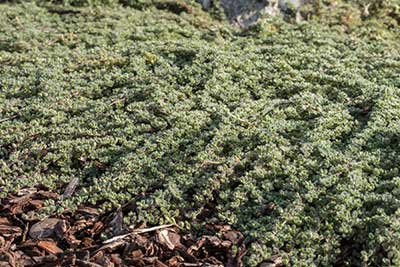Wooly Thyme
- Scientific Name: Thymus pseudolanuginosus
- Garden: Edibles and Herbs Garden, Xeriscaping Garden
- Plant Type: Ground Cover
- Evergreen/Deciduous: Evergreen
- Sun/Shade Exposure: Full Sun
- Moisture Requirements: Dry
Plant Information
There are 350 species of thyme. Most are frost hardy, small, aromatic evergreen perennials that flower late spring to mid-summer. Creeping or mat forming types generally are used as groundcovers, while the small shrub forms are used for culinary purposes. Thymes do best in sunny locations with well-drained soil. It is a good idea to pinch off old flowers to encourage new bushy growth. All species are drought tolerant (once established) and flower colors vary from white to pink and mauve. Blooms are also attractive to bees and butterflies. 1-3 feet tall, and 3 feet wide, forms low-spreading mat of wooly leaves, sparse scented pink flowers bloom in early summer. This variety is often planted between rocks.
Culture: Tolerates low fertility and sandy, dry soil.
Maintenance: The tips of the plants are often damaged over the winter. Shear off dead branches to generate new growth in the early spring. The larger varieties of thyme may get leggy and woody with age. Shear down to about 6 inches above the ground and shape in the spring every 3 years or so to rejuvenate. Heavy pruning should be completed by late August so that plants have time to harden for the winter.
Pests: None
Diseases: Rot is possible if the soil is not well-drained.
Propagation: From seed or by taking cuttings; dividing by ripping apart the patch into small pieces, in spring or early fall.
Data Source
https://www.portlandnursery.comPlant Photos







